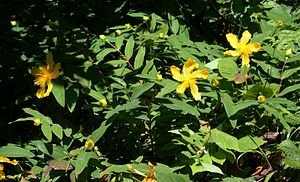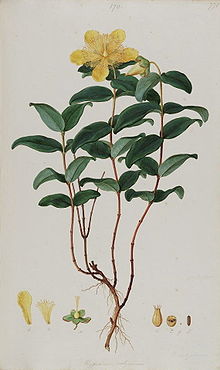Large Chalice St. John's Wort
| Large Chalice St. John's Wort | ||||||||||||
|---|---|---|---|---|---|---|---|---|---|---|---|---|

St. John's wort ( Hypericum calycinum ) |
||||||||||||
| Systematics | ||||||||||||
|
||||||||||||
| Scientific name | ||||||||||||
| Hypericum calycinum | ||||||||||||
| L. |
The Großkelchige St. John's Wort ( Hypericum calycinum ), also Evergreen St. John's wort called, is a plant from the genus of hypericum ( Hypericum ) in the family of hypericaceae (Hypericaceae).
description
St. John's wort is an evergreen, densely bushy shrub that is 20 to 60 centimeters tall. It spreads strongly with a creeping rhizome and underground runners . Its green-brown barked branches are ascending to upright, square and have two narrow longitudinal ridges.
The tightly cross-opposite leaves are short stalked or almost sessile. The simple, full-edged, leathery leaf blades are 45 to 85 millimeters long and 15 to 40 millimeters wide, narrow-elliptical to narrow-egg-shaped with a strongly narrowed blade base and blunt upper end. The upper side of the leaf is dark green and the lower side blue-green and dotted translucently due to oil glands.
The flowering period extends from July to September. The flowers sit individually, rarely in pairs or threes at the ends of the branches. The flower stalks are short to long. The very large flowers are 5 to 7 centimeters in diameter and have radial symmetry and five-fold with a double flower envelope . The five sepals are of different sizes, 16 to 20 millimeters long and 8 to 12 millimeters wide, narrow, obovate and round and not sloping at the top. The five bright golden yellow petals are 30 to 40 millimeters long, 12 to 20 millimeters wide, obovate and at the top blunt to round, lobed and sloping. The very numerous stamens are arranged in five fused groups on the ground and have long, delicate stamens and reddish anthers .
The broad pear-shaped capsule fruit is 10 to 14 millimeters long, brownish red and pendulous. The seeds are about 2 millimeters long, cylindrical, brown-black and striped lengthways through pit-shaped depressions.
Occurrence
The distribution area includes Greece, southeastern Bulgaria and Turkey. Often the large goblet of St. John's wort is also feral from culture .
The species can be found in sparse forests, on rocky slopes and on river banks. It does best in moist, sandy, nutrient-rich soils . The large goblet of St. John's wort can be found in shady locations from the plains to the hill country .
use
St. John's wort is used as an ornamental plant. Due to its vegetative characteristics (very fast growth) it is mostly used as a very good ground cover . Its large flowers attract many beneficial insects such as bumblebees and bees.
confusion
It is often mistakenly equated with the biblical rose of Sharon , although it is not native to the Levant .
supporting documents
- Gunter Steinbach (Ed.): Shrub trees (Steinbach's natural guide). Mosaik Verlag GmbH, Munich 1996, ISBN 3-576-10560-3 .
Web links
- Hypericum calycinum, evergreen hard hay. In: FloraWeb.de.
- Profile and distribution map for Bavaria . In: Botanical Information Hub of Bavaria .
- Hypericum calycinum L. In: Info Flora , the national data and information center for Swiss flora . Retrieved December 10, 2015.

